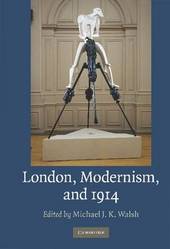
|
London, Modernism, and 1914
Hardback
Main Details
| Title |
London, Modernism, and 1914
|
| Authors and Contributors |
Edited by Michael J. K. Walsh
|
| Physical Properties |
| Format:Hardback | | Pages:316 | | Dimensions(mm): Height 229,Width 155 |
|
| Category/Genre | Art and design styles - Modernist design and Bauhaus
Literary studies - from c 1900 - |
|---|
| ISBN/Barcode |
9780521195805
|
| Classifications | Dewey:709.04 |
|---|
| Audience | | Undergraduate | | Postgraduate, Research & Scholarly | | Professional & Vocational | |
|---|
| Illustrations |
7 Halftones, unspecified
|
|
Publishing Details |
| Publisher |
Cambridge University Press
|
| Imprint |
Cambridge University Press
|
| Publication Date |
6 May 2010 |
| Publication Country |
United Kingdom
|
Description
The outbreak of the First World War coincided with the beginnings of high modernism in literature and the visual arts to make 1914 a pivotal moment in cultural as in national history. Yeats, Wyndham Lewis, Gaudier-Breszka, Sickert, Epstein and many other avant-garde artists were at work in London during 1914, responding to urgent political as well as aesthetic problems. London was the setting for key exhibitions of high modernist paintings and sculptures, and home to a number of important movements: the Bloomsbury Group, the Whitechapel Boys and the Vorticists among them. The essays in this 2010 book collectively portray a dynamic, remarkable year in the city's art world, whose creative tensions and conflicts were rocked by the declaration of war. A bold, innovative account of the time and place that formed the genesis of modernism, this book suggests new routes through the fields of modernist art and literature.
Author Biography
Michael J. K. Walsh is Associate Professor of Art History at the Eastern Mediterranean University, Cyprus.
Reviews"Readers of London, Modernism, and 1914 will be well equipped to survey the artistic, literary, cultural, and historical forces converging on modernism on the cusp of the war. This admirably conceived collection of ten essays centers on 1914 as an extraordinary year-not only because of the war's outbreak, but also because of the unprecedented "cultural dynamism" in Britain during the months leading up to August 4.....As Cork observes in his foreword, we can credit artists rather than generals for foretelling the conditions and consequences of the war, and this observation highlights the significance of the works examined by Walsh and his contributors. Lest we lose sight of those larger human consequences, though, we should note that the book concludes with an appendix including three letters from and about Walter Henry ("Harry") Walsh, Michael Walsh's granduncle (who died on the Somme, and to whom the book is dedicated).The sheer number of Great War casualties can unfortunately have a paradoxically numbing effect on our ability to comprehend an historical event that through its enormity defies representation. The poignantly detailed human specificity with which this book begins and ends, however -with Harry Walsh's photograph and firsthand accounts of his wounding and death- serves as a salutary reminder of the aims that can be served by such art and literature as that studied in this timely and compelling volume." -MARK D. LARABEE, U.S. Naval Academy "The essays in the book that negotiate the delicate and intricate relationship between nationalism and the cosmopolitanism of modernism in Britain c. 1914 offer new readings of the cultural politics of this period." -Sarah Victoria Turner, Association of Art Historians 2012 "There is much to be learnt and savoured here. It is sufficient to quote Wyndham Lewis's remark, appositely used by Walsh as the conclusion to his introduction: 'They talk a lot about how a war just-finished effects art. But you will learn here about how a war about to start can do the same thing.'" -David Boyd Haycock, The BRITISH ART Journal Volume XI, No. 2
|